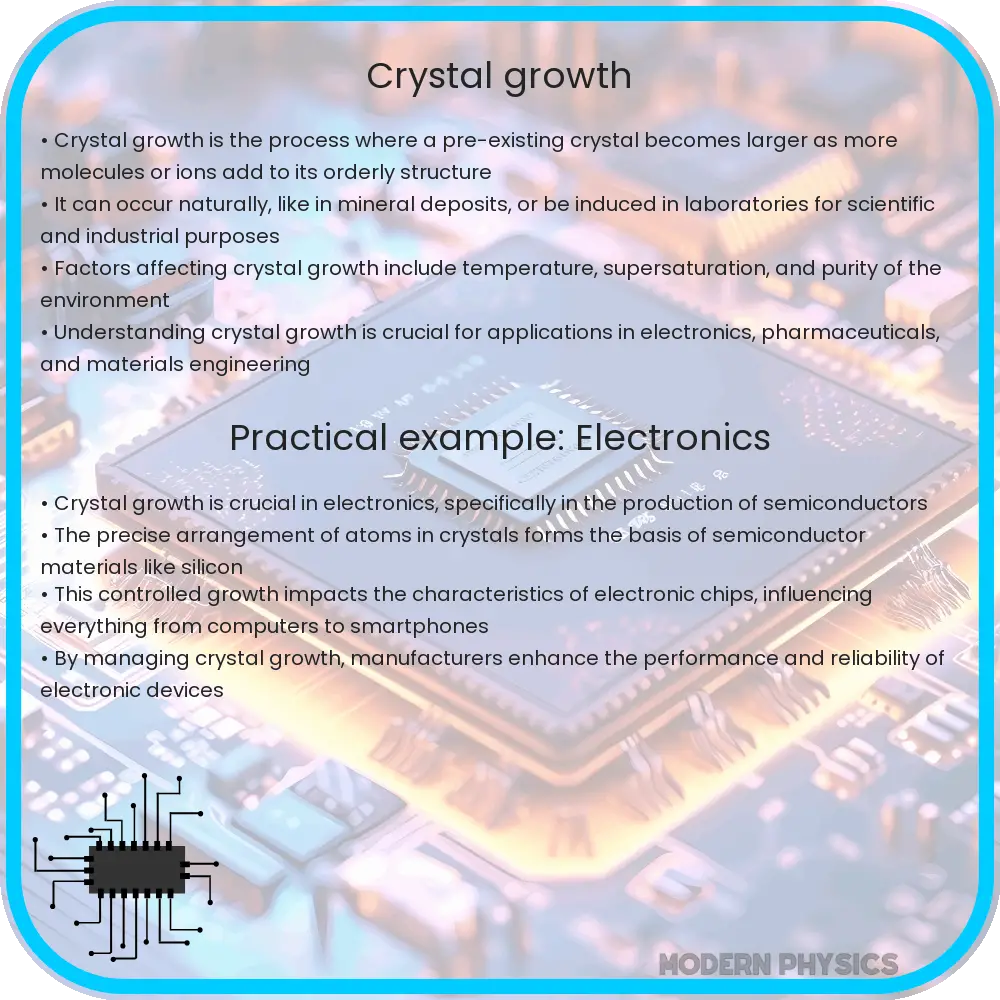Explore the fundamental science and various techniques of crystal growth used in industries like electronics and pharmaceuticals.

Understanding Crystal Growth: Fundamentals and Techniques
Crystal growth is a fundamental process in materials science that plays a crucial role in various applications across multiple industries. It involves the formation of a crystalline solid where the atoms or molecules are highly organized in a repeating pattern. This process not only affects the performance and quality of materials but also enables the production of new materials with tailored properties.
Fundamentals of Crystal Growth
The basis of crystal growth lies in the dynamic process of adding new atoms or molecules to a growing crystalline phase. This can occur naturally, such as the formation of snowflakes or gemstones, or it can be a controlled process in a laboratory or industrial setting. The primary goal in controlled crystal growth is to achieve a specific crystal size, shape, and defect-free structure to meet application standards.
At the microscopic level, crystal growth involves two main steps: nucleation and crystal growth. Nucleation is the initial step where a small number of atoms or molecules form a stable cluster that can serve as a seed for further growth. Once nucleation occurs, the crystal growth phase takes over, where additional atoms attach to this seed, expanding the crystal in a structured manner.
Techniques for Crystal Growth
Several techniques are employed to grow crystals, each being suitable for different materials and applications. Some of the most common methods include:
- Bridgman-Stockbarger Technique: This method involves slowly moving a container filled with the molten material through a temperature gradient in a furnace. The lower end of the container cools, promoting controlled crystal growth from the melt.
- Czochralski Process: Widely used in the semiconductor industry, particularly for silicon crystal growth, this technique involves dipping a seed crystal into molten material, then slowly pulling it up while rotating it, allowing the crystal to grow in size.
- Vapor Phase Growth: In this method, materials are vaporized in a hot zone and then transported to a cooler zone where they condense on a substrate, forming a crystal. This is common in the manufacturing of certain types of thin films and optical coatings.
Each technique has its advantages and drawbacks, which are typically assessed based on the crystal quality required, the material characteristics, and economic factors.
Applications of Crystal Growth
The applications of crystal growth are vast and influential in many sectors:
- Electronics: High-quality semiconductor crystals are foundational for fabricating components such as transistors, diodes, and integrated circuits.
- Optical Devices: Crystals with specific optical properties are crucial for lasers, lenses, and other optical components.
- Pharmaceuticals: Many drugs are manufactured in crystalline form to ensure proper dissolution and bioavailability.
The precise control of the crystal growth process influences not only the efficiency but also the performance of the end product in these applications. As technology progresses, the demand for novel materials with unique properties for advanced applications also grows, making crystal growth an even more critical subject of study and development in the field of materials science.
Challenges in Crystal Growth
While the benefits and applications of crystal growth are vast, this field also faces numerous challenges. Imperfections during the crystal growth process, such as impurities, structural defects, and inconsistent growth rates, can drastically affect the material’s properties. Advanced techniques such as the use of high-purity materials and precise environmental controls are often required to mitigate these issues.
Another challenge is scaling up from laboratory-sized samples to industrial quantities. Differences in scaling parameters can lead to significant variations in crystal quality, impacting its utility in commercial applications. Researchers constantly seek methods to ensure consistency and control over large-scale crystal growth processes.
Future Prospects in Crystal Growth
Future advancements in crystal growth promise to revolutionize multiple fields by enabling the development of materials with even more extraordinary properties. Innovations in crystal engineering, such as developing more effective seed crystals and refining growth environments, are likely to further enhance the precision and efficiency of crystal growth methods.
Additionally, the integration of machine learning and AI into crystal growth processes could provide predictive insights into growth outcomes, optimize conditions, and troubleshoot issues in real-time, leading to greater control and consistency in material production.
Conclusion
Crystal growth is a foundational aspect of materials science, influencing advancements in many high-tech industries. From electronics to pharmaceuticals, the controlled manipulation of crystal growth facilitates the development of new materials that propel technological and scientific progress. Despite the challenges faced, the field continues to evolve, driven by both technological advancements and a deeper understanding of crystalline processes. As researchers tackle the challenges of scaling and consistency, the future of crystal growth holds the promise of creating even more innovative and transformative materials. With ongoing research and technological upgrades, the precision in crystal growth will undoubtedly reach new heights, paving the way for exciting developments across various scientific disciplines.
